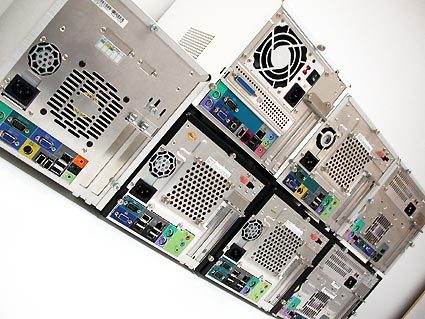No More Penny-Pinching: Seven Mini-PCs On The Catwalk
Summary: Aopen - Successful Start. Shuttle Still The Standard
The range of mini-barebones on offer was never so wide as it is today. Quality and performance don't come cheap: you have to cough up $383 (300 euro) at least for one of our test candidates - the most expensive model is the XPC SB61G2 Reflexion special model from Shuttle at just under $536 (420 Euro). But you do get all the features you could possibly want for your money, including, for example, WLAN.
And there are more and more aesthetically pleasing products on the market, too: form and color with regard to an aluminum case and adventurous innovations with regard to detail solutions indicate somewhat the direction the compact PC market is taking. A classy look becomes important when the market is increasingly saturated with discount PCs and customers are fed up with grey boxes boasting dubious performance specifications.
Manufacturers also offer cases with a volume of just under 11 liters. Compare this: a classic tin tower has a volume of at least 50 liters - larger big towers even have volumes up to 65 liters.
Very rare: parallel interfaces to connect older printers
Due to the crowded configuration of electricity-devouring components, a conflict of purposes automatically arises: the high degree of heat build-up requires a sophisticated cooling concept. There is enormous scope for development work, precisely with regard to this aspect. Most mini-PCs at full capacity currently make significantly more noise than comparably fitted tower systems. But systems such as the Soltek EQ3701M and, to some extent, some of the XPC Shuttle models show what can be done with conventional aids (fans).
A quick run-down of some highlights of this test: two systems with powerful ATI graphics (IGP9100 onboard) - Biostar iDEQ 200A and Shuttle XPC ST61G4 - are also suitable for newer 3D games because of their DirectX-8.1 compatibility. Not so the Intel 865G (DirectX 7) and Nvidia NForce 2 (DirectX 7 with GeForce-2 core), which are completely outmoded and only good for 2D applications. If you want to get the most out of current DirectX-9 games, sooner or later you'll have to get yourself an AGP graphic a lá GeForce FX5950 or Radeon 9800.
The Aopen with the XC Cube EZ65 is a winner right from the start, a sleek combination of great looks and good equipment coupled with neat details. Soltek sets the tone with the EQ3701M's very low running noise - similar to the previous test. Biostar is putting up some competition for Shuttle: the manufacturer likewise offers a mini-system for the Athlon 64 (Socket 754) - for under $383 (300 Euro).
Get Tom's Hardware's best news and in-depth reviews, straight to your inbox.
That just leaves us wishing for an integrated DVI interface so that the mini-PC could give optimum output with a TFT monitor. Or how about HDMI straight off?
Current page: Summary: Aopen - Successful Start. Shuttle Still The Standard
Prev Page Soltek QBIC EQ3701M, Continued

